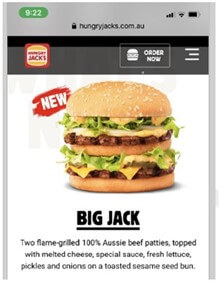McDonald’s trade mark registration for BIG MAC is not infringed by Hungry Jack’s use of the mark BIG JACK according to the Federal Court of Australia decision in McD Asia Pacific LLC v Hungry Jack’s Pty Ltd [2023] FCA 1412.
Hungry Jack’s began promoting its BIG JACK burger in March 2020. An example of Hungry Jack’s advertising which formed part of the evidence in this case is shown below:

Like the BIG MAC, the BIG JACK has two beef patties, melted cheese, special sauce, lettuce, pickles, onion in a sesame seed bun with a slice of bread in the middle.
McDonald’s submitted that Hungry Jack’s deliberately chose a similar trade mark for its “copycat” product to promote a connection or affiliation with the BIG MAC. Hungry Jack’s denied this and gave evidence that it was aware that there was an element of cheekiness in naming the product BIG JACK, due to the rhyming of “Jack” and “Mac”. However, its decision to introduce the burger was to encourage consumers to compare the BIG JACK with the BIG MAC, rather than confuse customers that the BIG JACK burger was associated with the BIG MAC.
The Federal Court agreed with Hungry Jack’s on this point, and found that the trade marks BIG MAC and BIG JACK were not deceptively similar. The Court considered that unlike MAC, the word JACK is an easily recognised first name and would be understood as such by most consumers. It found that typical consumers would be unlikely to confuse JACK for MAC or BIG JACK for BIG MAC.
In its analysis, the Court took into account the recent High Court decision of Self Care v Allergan [2023] HCA 8, and confirmed that the reputation that McDonald’s has in its BIG MAC trade mark is irrelevant when assessing deceptive similarity. Further, the Court rejected Hungry Jack’s argument that the decision in Self Care required consideration of the usage of other aspects of packaging for its BIG JACK burger such as other trade marks, branding and livery used by Hungry Jack’s in relation to the burger.
Whilst Hungry Jack’s was successful in defending the trade mark infringement action, it was found to have engaged in misleading or deceptive conduct arising from its television commercials where it compared the BIG JACK to the BIG MAC. The commercials made the statement “But the Big Jack’s clearly bigger with 25% more Aussie beef.”
McDonald’s put on evidence from food analysts who visited Hungry Jack’s and McDonald’s stores to weigh the hamburger meat patties. They found that the average cooked weight of the BIG JACK beef patties was no more than 15% greater than the beef patties in the Big Mac.
Hungry Jack’s position was that the statement was accurate as it was referring to the uncooked weight of the beef patties. The Court disagreed, and found that the advertisement misrepresented to consumers that the BIG JACK hamburger contains 25% more Aussie beef than the BIG MAC when cooked which was in breach of the Australian Consumer Law.
The case highlights that when considering whether there is trade mark infringement, it is important to assess the registered trade mark with the allegedly infringing mark, and not take into account any reputation in either mark or other branding that is used with the allegedly infringing mark. It is also a reminder of the level of care that needs to be taken when making comparative advertising claims.

